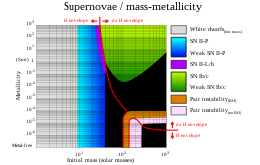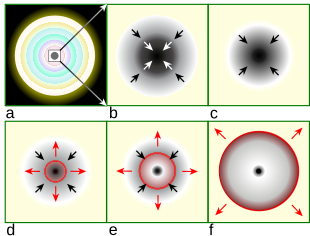Supernova types by initial mass-metallicity
The layers of a massive, evolved star just prior to core collapse (not to scale)
Very massive stars can undergo core collapse when nuclear fusion
becomes unable to sustain the core against its own gravity; passing this
threshold is the cause of all types of supernova except Type Ia. The
collapse may cause violent expulsion of the outer layers of the star
resulting in a supernova, or the release of gravitational potential
energy may be insufficient and the star may collapse into a black hole or neutron star with little radiated energy.
Core collapse can be caused by several different mechanisms: electron capture; exceeding the Chandrasekhar limit; pair-instability; or photodisintegration. When a massive star develops an iron core larger than the Chandrasekhar mass it will no longer be able to support itself by electron degeneracy pressure and will collapse further to a neutron star or black hole. Electron capture by magnesium in a degenerate O/Ne/Mg core causes gravitational collapse
followed by explosive oxygen fusion, with very similar results.
Electron-positron pair production in a large post-helium burning core
removes thermodynamic support and causes initial collapse followed by
runaway fusion, resulting in a pair-instability supernova. A
sufficiently large and hot stellar core
may generate gamma-rays energetic enough to initiate
photodisintegration directly, which will cause a complete collapse of
the core.
The table below lists the known reasons for core collapse in
massive stars, the types of stars in which they occur, their associated
supernova type, and the remnant produced. The metallicity
is the proportion of elements other than hydrogen or helium, as
compared to the Sun. The initial mass is the mass of the star prior to
the supernova event, given in multiples of the Sun's mass, although the
mass at the time of the supernova may be much lower.
Type IIn supernovae are not listed in the table. They can be
produced by various types of core collapse in different progenitor
stars, possibly even by Type Ia white dwarf ignitions, although it seems
that most will be from iron core collapse in luminous supergiants or hypergiants (including LBVs).
The narrow spectral lines for which they are named occur because the
supernova is expanding into a small dense cloud of circumstellar
material. It appears that a significant proportion of supposed Type IIn supernovae are supernova impostors, massive eruptions of LBV-like stars similar to the Great Eruption of Eta Carinae.
In these events, material previously ejected from the star creates the
narrow absorption lines and causes a shock wave through interaction with
the newly ejected material.
| Cause of collapse | Progenitor star approximate initial mass (solar masses) | Supernova type | Remnant |
|---|---|---|---|
| Electron capture in a degenerate O+Ne+Mg core | 9–10 | Faint II-P | Neutron star |
| Iron core collapse | 10–25 | Faint II-P | Neutron star |
| 25–40 with low or solar metallicity | Normal II-P | Black hole after fallback of material onto an initial neutron star | |
| 25–40 with very high metallicity | II-L or II-b | Neutron star | |
| 40–90 with low metallicity | None | Black hole | |
| ≥40 with near-solar metallicity | Faint Ib/c, or hypernova with gamma-ray burst (GRB) | Black hole after fallback of material onto an initial neutron star | |
| ≥40 with very high metallicity | Ib/c | Neutron star | |
| ≥90 with low metallicity | None, possible GRB | Black hole | |
| Pair instability | 140–250 with low metallicity | II-P, sometimes a hypernova, possible GRB | No remnant |
| Photodisintegration | ≥250 with low metallicity | None (or luminous supernova?), possible GRB | Massive black hole |
Remnants of single massive stars
Within
a massive, evolved star (a) the onion-layered shells of elements
undergo fusion, forming an iron core (b) that reaches Chandrasekhar-mass
and starts to collapse. The inner part of the core is compressed into
neutrons (c), causing infalling material to bounce (d) and form an
outward-propagating shock front (red). The shock starts to stall (e),
but it is re-invigorated by a process that may include neutrino
interaction. The surrounding material is blasted away (f), leaving only a
degenerate remnant.
When a stellar core is no longer supported against gravity, it collapses in on itself with velocities reaching 70,000 km/s (0.23c),
resulting in a rapid increase in temperature and density. What follows
next depends on the mass and structure of the collapsing core, with low
mass degenerate cores forming neutron stars, higher mass degenerate
cores mostly collapsing completely to black holes, and non-degenerate
cores undergoing runaway fusion.
The initial collapse of degenerate cores is accelerated by beta decay, photodisintegration and electron capture, which causes a burst of electron neutrinos.
As the density increases, neutrino emission is cut off as they become
trapped in the core. The inner core eventually reaches typically 30 km diameter and a density comparable to that of an atomic nucleus, and neutron degeneracy pressure tries to halt the collapse. If the core mass is more than about 15 M☉ then neutron degeneracy is insufficient to stop the collapse and a black hole forms directly with no supernova.
In lower mass cores the collapse is stopped and the newly formed neutron core has an initial temperature of about 100 billion kelvin, 6000 times the temperature of the sun's core. At this temperature, neutrino-antineutrino pairs of all flavors are efficiently formed by thermal emission. These thermal neutrinos are several times more abundant than the electron-capture neutrinos. About 1046
joules, approximately 10% of the star's rest mass, is converted into a
ten-second burst of neutrinos which is the main output of the event. The suddenly halted core collapse rebounds and produces a shock wave that stalls within milliseconds in the outer core as energy is lost through the dissociation of heavy elements. A process that is not clearly understood is necessary to allow the outer layers of the core to reabsorb around 1044 joules (1 foe)
from the neutrino pulse, producing the visible brightness, although
there are also other theories on how to power the explosion.
Some material from the outer envelope falls back onto the neutron star, and, for cores beyond about 8 M☉,
there is sufficient fallback to form a black hole. This fallback will
reduce the kinetic energy created and the mass of expelled radioactive
material, but in some situations it may also generate relativistic jets
that result in a gamma-ray burst or an exceptionally luminous supernova.
The collapse of a massive non-degenerate core will ignite further
fusion. When the core collapse is initiated by pair instability, oxygen
fusion begins and the collapse may be halted. For core masses of 40–60 M☉,
the collapse halts and the star remains intact, but collapse will occur
again when a larger core has formed. For cores of around 60–130 M☉,
the fusion of oxygen and heavier elements is so energetic that the
entire star is disrupted, causing a supernova. At the upper end of the
mass range, the supernova is unusually luminous and extremely long-lived
due to many solar masses of ejected 56Ni. For even larger
core masses, the core temperature becomes high enough to allow
photodisintegration and the core collapses completely into a black hole.




